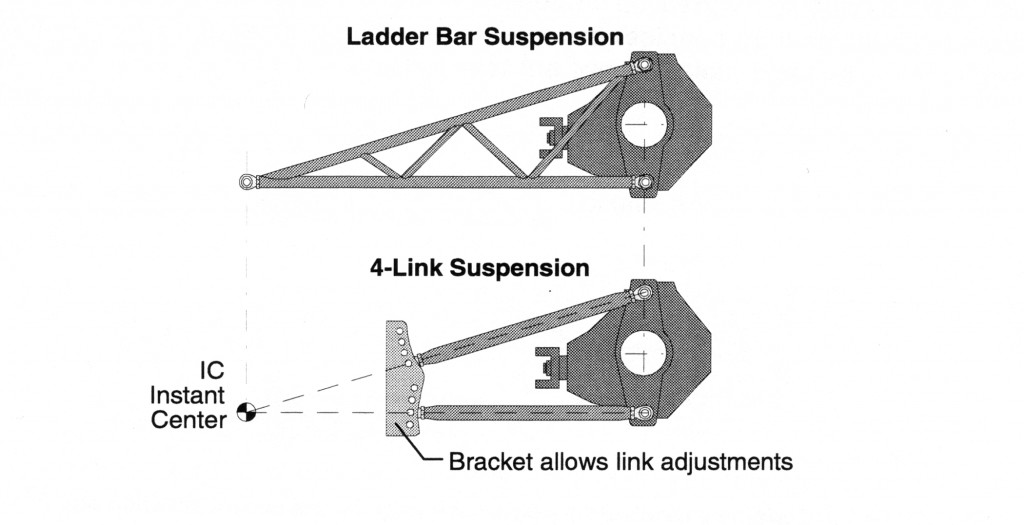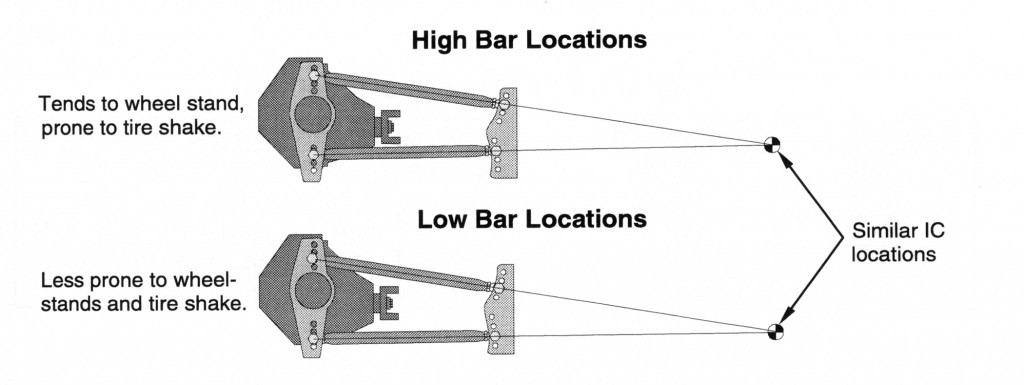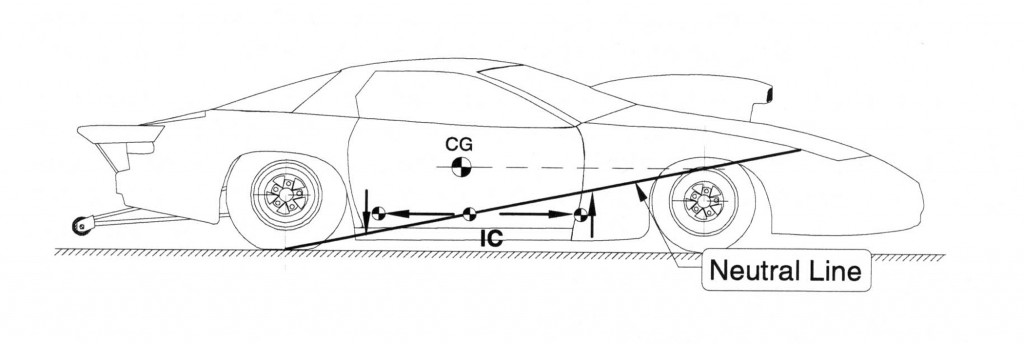How To Set Up A 4 Link
Over the years, elevate racers with door cars accept gone through all sorts of interruption arrangements. Lift bars, slapper bars, Super Stock springs, leaf links, ladder bars, three-links, four-links, and torque artillery (there may be others likewise, but it'due south a start). Of all of the systems, the most common you'll see today is the equal length four-link, probably followed by the ladder bar.
To complicate things, there has been quite a bit penned over the years regarding break setup–some right and some wrong (some very seriously wrong). That has led to all sorts of misinformation, which in turn is bad news for the racer. What we've done here is cutting through the maze of information (adept and bad) and we've gone straight to an established expert on the subject–Jerry Bickel.
Information technology should be no surprise to anyone reading this that Bickel has built more his fair share of championship winning race cars, and he is certainly no stranger to tuning suspension systems. What yous'll come across beneath is Bickel's personal have on ladder bars and four-link setups.
Ladder Bars
Permit'due south showtime at the beginning.
When a drag auto launches, the rear-end wraps up. The purpose of a traction device is to plow that wrap-up into forwards motion.
Consider the case of a ladder bar.
This is a unproblematic triangular-shaped device that connects the rear-finish housing to the frame. The ladder bar prevents excessive suspension wrap up by pushing upwardly on the frame at the bespeak of forward connection (basically the point where the upper and lower bars of the ladder bar intersect). The front of the auto is lifted or "picked up" by this section. As a result, the forward attachment bespeak is chosen the pickup point. If the car has ii ladder confined (equally nearly all practise), there are really 2 pickup points–1 on each side of the motorcar (see illustration #1 below).

Analogy i.
Analogy #ane
Consider what happens when the ladder confined push button up on the chassis at the pickup point. The respective bar on each of the motorcar too pushes down on the tires and wheels. This effectively "plants" the tires, which in turn, makes the auto hook (or at least, that'southward the hope!).
That all makes sense, merely over time racers quickly discovered that changes in that pickup point location can accept a considerable influence upon the behavior of the chassis. If, for instance, the pickup points were short and loftier, then the launch would prove violent. This regularly resulted in the slicks wadding up at the launch. Following this initial vehement hit, there usually wasn't sufficient load transfer to actually maintain traction and keep the tires hooked. Betwixt an excessive corporeality of tire wadding coupled with the reduced traction post-obit the violent hook, elapsed times tin suffer (no brainer, we're sure).
Hither'southward something else to consider is this: A ladder bar with a short, high pickup bespeak can also create considerable body separation during the launch. It definitely looks wild, only information technology also can issue is horrendous driveshaft alignment–the results of which tin can prove disastrous.
So instead of a short, high pickup point, what if yous had a long, depression pickup point? Bickel tells us that this arrangement volition tend to hit the tires less violently, but it can also create more full load transfer to the rear tires. Bickel notes that this is by and large an acceptable situation, but if yous go also far, the chassis may squat excessively or worse, rattle the tires.
The large question with a ladder bar setup is this: How do you make the ladder bar adjustable so that you can melody information technology from a range of brusk, high pickup indicate to long, low pickup betoken?
Information technology's non that uncomplicated.
It can exist accomplished with several different ladder confined along with several different forepart ladder bar mounting positions. If you brainstorm with a iv-link, Bickel notes that it is entirely possible to create both pickup bespeak extremes (short and high versus long and depression). Bickel goes on to tell us that the ideal pickup bespeak locations for a race auto are dependent upon multiple factors. But there is one truth: All race cars all accept a neutral line that determines how the chassis will carry (encounter analogy 2 below). If the pickup point is located virtually this line, the trunk will dissever upon acceleration. If the pickup point is located beneath this neutral line, the body will squat.

Illustration two
In a perfect situation, the front pickup betoken should exist located near the neutral line. This setup will ultimately piece of work well and testify very stable. The automobile will neither testify squat, nor will information technology come across excess body separation. The dilemma here is how do you actually effigy out the neutral line location?
Typically the line of thought states that the neutral line of a drag car can be adamant by extending a line level with the top of the center of gravity (CG) until information technology crosses a vertical line through the front end spindle. The neutral line is then represented as a diagonal line that intersects this location and the eye of the rear tire-to-pavement contact point (come across illustration 3 below).

Analogy three
So far so skillful, but Bickel points out that there are several difficulties with this method.
"It is difficult to measure the height (Y) of the CG accurately," Bickel said. "Nigh racers use the camshaft centerline equally the CG top, simply without an accurate measurement, it is impossible to locate the neutral line with precision.
"Another problem with this traditional neutral line location theory is that many drag race cars wheel stand through depression gear. Once the front tires are in the air, I do not believe that they have an effect upon neutral line location. Experience has shown u.s. that the pickup point altitude from the rear axles is at least as important as its height.
"In practice, I find that pickup signal location must be changed, depending upon race rail conditions and vehicle operation. You should rely on conventional neutral line theory only as a starting point for rear suspension setup."
Chassis Instant Heart
That changes things, and nosotros're not finished with it withal.
What nosotros need is an thought of something chosen the "instant center."
What is instant center? The instant eye or "IC" is an imaginary point nearly which the chassis or a suspension fellow member rotates in a given (instant) position. You can notice it by simply projecting lines along suspension members to a signal of intersection (for example, the respective bars of a iv-link). Where they intersect is called the instant center (see Illustration 4 below). If y'all examine Jerry Bickel's drawing, you can see that the 4-link has an instant center that acts as a pickup point, even though the bodily point is invisible.

Illustration 4
Because the respective brackets plant on something like a four-link are nether load during dispatch and braking, they must be stout. When the race machine accelerates, the rear-terminate wraps upward, placing the upper bars in tension while the lower bars are held in pinch. As you brake, the forces are reversed.
Establishing Four-link Instant Center
When you or your chassis builder installs the rear-end in your machine with a four-link setup, that's the fourth dimension to decide exactly which bracket holes you will utilize for the links. The choices fabricated here will make up one's mind the length and elevation of the instant center. These decisions will ultimately touch how the motorcar works.
Bickel tells us that if you drive the tire downwards too hard by way of the IC location, it tends to fold upwards the sidewalls, which in turn makes for poor surface contact. Opposite to this, if insufficient force is applied to the tire, it will but spin without accelerating the race auto. If you wait closely at Bickels's analogy (below), it's easy to see in that location are many possible IC locations in a four-link. Y'all accept to pick the one that works best for your particular machine, simply it'south not cut and dry.

Illustration 5
And so where practise yous begin?
Bickel offers a very simple caption to choose the IC pickup points:
"Long, low intersect points create traction for the longest fourth dimension, but react slowly," he said. "Brusque loftier intersect points create traction for the least fourth dimension, but react fast."
Figuring The IC Length
The next thing you'll accept to practise is to decide the IC length.
The instant centre length can actually affect the overall (race car + driver) reaction time. Bickel states that if your reaction times are good, a long IC signal (50-sixty inches is mostly more desirable than a short i (50 inches or less). This volition found the tires smoothly and proceed them planted a long fourth dimension. Nevertheless, as nosotros noted much earlier in this article, if likewise much power is applied to a long IC point, tire shake can outcome.
The other consideration Bickel tells us about is the amount of torque your engine can evangelize to the drivetrain coupled with the type of drag slicks y'all have.
"For instance, racers of high-powered Pro Modernistic cars often employ tires that were initially designed for solid break Funny Cars and Top Fuel dragsters," he said. "The sidewalls of these tires are tall and very flexible, interim similar a sort of spongy break system. They work best when y'all limit the rear movement to as piffling as possible with an IC indicate on or about the neutral line of the car.
"Farther to this, I like to run a long, low IC point in an application such as a loftier rpm, lower horsepower small-scale block clutch car. This combination seems to help overcome the touch from the high rpm launch and the engine usually doesn't have enough power to milkshake the tires."
Remember when we initially talked nearly location of the bars in the four-link?
That location relative to the rear axle centerline volition make a difference in functioning, even if the IC betoken remains the same. The closer to the housing the upper bar is, the less the car tends to bicycle stand. Bickel's experience shows that when the bottom bar is located lower in the car the break, it seems to accept better control and simultaneously is less apt to feel tire shake (see illustration 6 beneath).

Illustration 6
Figuring The IC Elevation
The neutral line (examined previously) slopes inside the car from forepart to rear. Bickel says that should you decide to change the length of the IC, y'all must as well alter the tiptop in guild to maintain the aforementioned anti-squat relationship.

Analogy 7
When it comes to IC height, Bickel has this to add:
"The further forward you move the IC, the lower it must be," he said. The further back y'all motility the IC, the higher it must be."
Some other food for idea is this (again, from Bickels'southward tuning pocketbook of tricks): Automatic transmission cars along with lower torque stick shift cars work best when the IC point is from one- 2 inches to a higher place the racing surface. Big power stick shift cars typically need to stay three-seven inches above the racing surface.
The lesser line here is you have to take your time setting up the four-link for your particular auto. Like any other part of the race auto, Bickel recommends you follow the higher up methodology and that you make but i change at a time. It'southward very important to proceed notes of the changes too.
You tin melody your four-link.
There'due south admittedly no voodoo or black magic involved.
SOURCE: Jerry Bickel Race Cars
Source: https://www.onallcylinders.com/2015/04/23/figure-four-a-guide-to-tuning-your-four-link-suspension-system/

0 Response to "How To Set Up A 4 Link"
Post a Comment